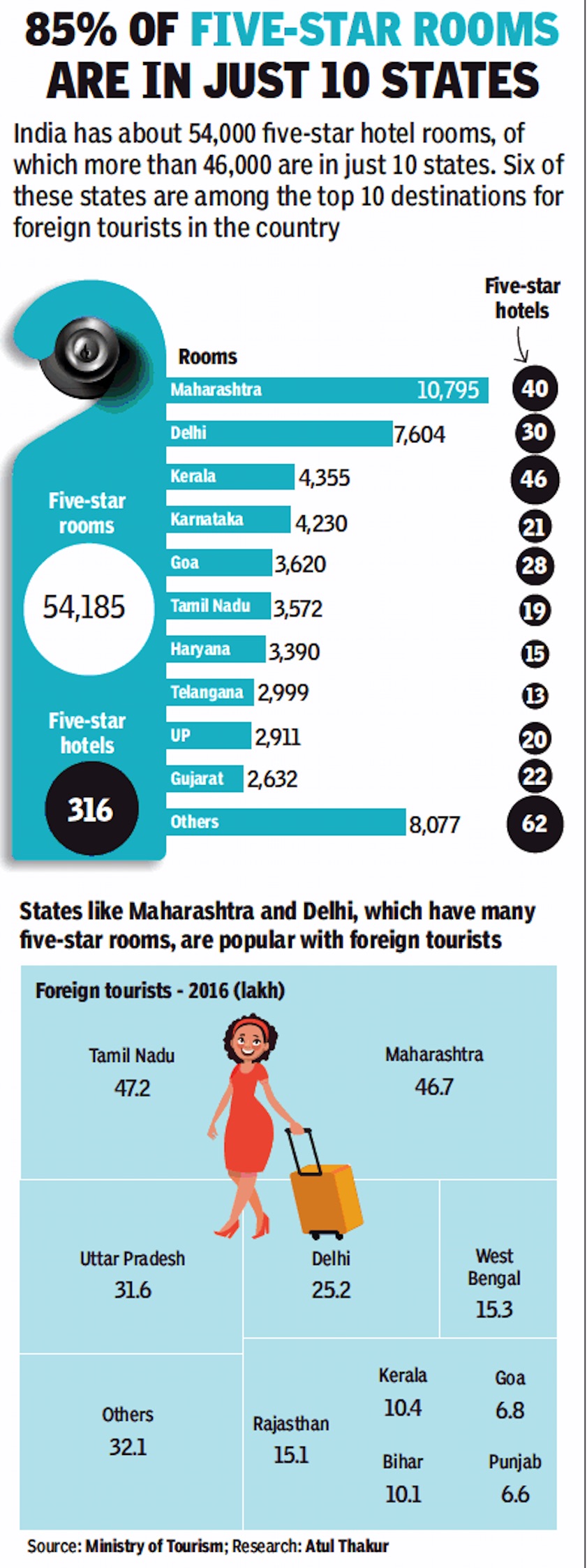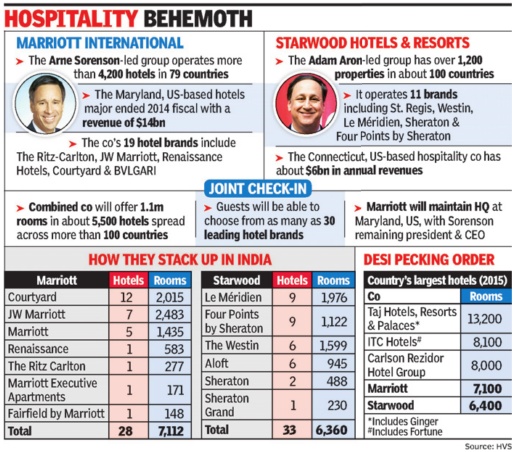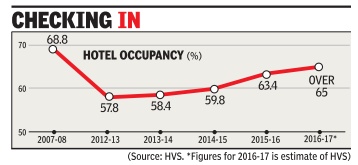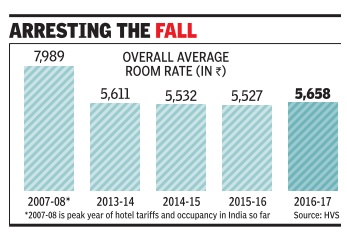Hotels: India
This is a collection of articles archived for the excellence of their content. Readers will be able to edit existing articles and post new articles directly |
Contents |
Geographical spread of hotels within India
Top ten states host 85% of 5-star rooms

ii) The ten states that attracted the greatest number of international tourists in 2016.
From: May 10, 2018: The Times of India
See graphic :
i) The top ten states that account for 85% of India’s 5-star rooms, presumably as in 2017;
ii) The ten states that attracted the greatest number of international tourists in 2016.
2015, number of rooms in hotel chains

See graphic:
The number of rooms that hotel chains have in India, November 2015
Indian hotels' place and rank in the world
2014: Mumbai no. 65, Delhi no. 90 out of 100 destinations
Delhi hotels are amongst the worst in the world: Online survey
PTI | Mar 2, 2014
Hotels in Delhi are considered as one of the worst in the world as per the trivago Reputation Ranking of 100 destinations which places them in the 90th position, while those in Mumbai have fared better.
The ranking is based on over 82 million reviews compiled by trivago from over 200 online booking websites. Trivago is the world's largest online hotel search site which compares rates at over 700,000 hotels on over 200 booking sites worldwide.
"The national capital lands on the bottom of the list of 100 destinations...Mumbai took the 65th position with a score of 78.90 per cent, whereas Delhi was placed on the 90th position in the list with a score of 77.70 per cent," a recent trivago Reputation Ranking report said. It considers hotels with over 60 reviews and cities with over 130 hotels.
South East Asia and Paris even worse
Many other Asian destinations, including Kuala Lumpur (Malaysia), Pattaya (Thailand) and Manila (Philippines), are at the bottom of the list. Kuala Lumpur was ranked 94, Pattaya (Thailand) 95, Singapore 97, Bandung (Indonesia) 98, Jakarta (Indonesia) 99 and Manila (Philippines) 100.
The bottom list also included Rio de Janeiro (Brazil) (91) which is hosting the football world cup this year, while the vaunted Paris is in the 92nd position.
2016
TripAdvisor's 'Travellers' Choice [World/ Asia]
Umaid Bhawan Palace ranked world's top hotel: Report
Jodhpur's Umaid Bhawan Palace has been adjudged the best hotel in the world based on reviews and opinions collected by travel site TripAdvisor. The majestic sandstone edifice with 347 rooms has bagged No. 1 spot in the global top hotels category, according to TripAdvisor's 'Travellers' Choice awards for Hotels'.
Orange County Resorts in Mysore at No. 13 is the only other Indian property to feature in the list of 25 best hotels in this category.
In the luxury category, The Oberoi Vanyavilas, Sawai Madhopur secured sixth position
Taj Rambagh Palace, Jaipur was at 15.
In the best bargain category in Asia,
Bougainvillea Guest House (Goa) featured in the third position,
Hotel Pearl Palace (Rajasthan) at the fourth
Kaiya House in Kerala at the sixth spot.
TripAdvisor's 'Travellers' Choice [India's Top 25]
1 Umaid Bhawan Palace Jodhpur Jodhpur, India
2 Orange County Resorts Kabini Nagarhole National Park, India
3 Taj Lake Palace Udaipur Udaipur, India
4 Wildflower Hall, Shimla in the Himalayas Mashobra, India
5 The Oberoi Rajvilas Jaipur, India
6 Orange County, Coorg Siddapura, India
7 Taj Rambagh Palace Jaipur, India
8 The Oberoi Cecil, Shimla Shimla, India
9 The Oberoi, Bangalore Bengaluru (Bangalore), India
10 Suryagarh Jaisalmer, India
11 The Oberoi Amarvilas Agra, India
12 Kolahoi Green Resorts Pahalgam Pahalgam, India
13 Niraamaya Retreats Kovalam, India
14 The Oberoi Udaivilas Udaipur, India
15 The Leela Palace New Delhi New Delhi, India
16 The Panoramic Getaway Chithirapuram [Munnar Hills, Kerala], India
17 RAAS Jodhpur, India
18 Amanbagh Resort Ajabgarh, India
19 The Oberoi, New Delhi New Delhi, India
20 The Riverview Retreat Jim Corbett National Park, India
21 The Tamara Coorg Yavakapadi Village, India
22 The Solluna Resort Jim Corbett National Park, India
23 Taj Exotica Goa Benaulim, India
24 Aahana the Corbett Wilderness - an Eco Friendly Resort Jim Corbett National Park, India
25 Bella Vista Resort Mahabaleshwar, India
Occupancy rates
Hotel occupancy, year-wise, 2007-17
Saurabh Sinha, Bouncing back: Hotel occupancy soars , May 16, 2017: The Times of India
Saurabh Sinha, `Hotel occupancy highest in 10 years', October 19, 2017: The Times of India


From: Saurabh Sinha, `Hotel occupancy highest in 10 years', October 19, 2017: The Times of India
Tariffs To Rise As Room Supply Ebbs: Study
The domestic hospitality sector has staged a smart recovery from the slowdown of past. Hotels have not only recorded over 65% occupancy in 2016-17 for the first time since 2007, average room rates (ARRs) are now the highest in last four years. The overall average (across segments) ARRs was Rs 5,658 in 2016-17, arresting the constant fall in rates seen since 2010-11, according to a report, `Hotels in India -Trends and Opportunities (2017)', by hotel consultancy firm HVS, which was released earlier this month.
The domestic travel industry has turned the tide. It has bounced back from the long slowdown since 2007.In the last financial year (201617), hotels across all segments recorded occupancy of over 65% for the first time in eight years, according to hospitality consultancy firm HVS. Indian hotels had seen their rooms this full last time in 2007-08.
The revival continues on a strong note in the current financial year, too. Tariffs are now likely to rise for the next four to five years as new supply is ebbing. HVS said the demand-supply equation today and in the next 48-60 months is more than likely to present an opportunity for substantial average rate enhancement.
Achin Khanna, MD of consulting and valuation at HVS South Asia, said, “While data for FY 2016-17 is still being collected, initial indicators showed over 65% occupancy after eight years. This has happened due to the overall economic growth that has led to travel picking up which requires accommodation. Domestic leisure travel has picked up in a big way .“
Chinmai Sharma, chief revenue officer for the Taj Group, said the domestic Indian leisure traveller is one of the fastest growing customer seg ments, which has also reduced dependence of luxury chains on international travellers.“We are witnessing an increase in international arrivals in India for number of reasons like improvement in ease-ofdoing business and e-visas to nationals of more countries.Given the current global scenario, India is also being seen as a safe destination with a lot of unexplored potential at a reasonable cost,“ said Sharma.
Hotel room supply in India grew at 7-8% last year and is expected to be at the same range for the next three years.On the other hand, demand is growing at 11-14%. “With demand outweighing supply and outlook for travel remains positive, the upward trend is expected to continue,“ said JeanMichel Cassé, COO of AccorHotels (India and South Asia).
However, average room tariff (of all segments ranging from five start deluxe to two stars) are nowhere close to the level of Rs 7,989 in 2007-08.While guests are returning to hotels, average tariff is still around 30% lower at Rs 5,500, according to HVS, which monitors branded or organised sector hotels across segments.
Jean-Michel Cassé, said: “Steady flow of foreign tourists, pick-up in leisure activities and growing business travel fuelled the growth for hospitality players in India over the past couple of years. After a few dips along the way , the sector witnessed an upcycle recently as the nationwide weighted occupancy swelled by 6%, reaching a five-year high of over 60% in FY16.... The trend has continued well into this year, with some of the leading branded players reaching up to 65% and higher occupancy so far in 2017, highest the sector has recorded in almost a decade.“
Kapil Chopra, president of the Oberoi Group, said: “We are seeing a more robust demand pipeline this year as compared to last year. The sentiment is positive and we see good business for the summer and winter season. We believe if the momentum that has just started to build continues, then we could see close to a 10% growth in average room rates led by our resort hotels.“
The biggest hotel chains
2016: Marriott dethrones Taj
For the first time, a foreign chain has become the No.1 player in India's hospitality sector, dethroning homegrown brand Taj that held the top position for decades. Marriott's global acquisition of Starwood has catapulted the American chain from the fourth position to the top slot in Asia's third largest economy .
The Maryland-based lodging company , which entered India in December 1999 with the Goa Marriott resort, now has 18,000 rooms in its portfolio as against Taj's 14,000. “The Starwood purchase has more than doubled our India footprint,“ said Marriott's Asia-Pacific head Rajeev Menon. Prior to the acquisition, Marriott had 8,000 rooms in the country.
Starwood's local operations have been combined with Marriott Hotels India, which is overseen by Menon out of Singapore. Currently , both Starwood and Marriott's India heads -Dilip Puri and Neeraj Govil -report to Menon. “We will come out with a new organisational structure in some weeks,“ said Menon, adding that there will be no layoffs, something that usually follows mergers and acquisitions. Menon said that since the company is in an expansion mode with 100 hotels in the pipeline, it needs people and will not let go of employees, highlighting that its expansion tracks India's growth story . India, where the hotels sector is witnessing high-teen growth rate, is the second most important market for Marriott after China within Asia Pacific, said Menon.
While Marriott leads in India in terms of room capacity, it remains behind Taj in terms of number of hotels.Taj, which opened its first property in Mumbai in December 1903, has 108 hotels in the country in comparison to Marriott's 79. Before Starwood came into its kitty , Marriott had 33 properties.
Marriott 1st international chain to have 100 hotels
In a first for a foreign hospitality player in India, the number of hotels Marriott Inter national operates in the country, along with franchises, has touched 100. The milestone makes India the third country, after China and the US, where the over $17-billion Marriott has 100 or more properties.
“Five years ago, when we said we will have 100 hotels in India, nobody really believed it, but here we are,” said Arne Sorenson, president and CEO, Marriott International. Marriott opened its 100th hotel — the Sheraton Grand Benguluru.
While the three-digit number boosts Marriott’s hotel portfolio, it is yet to catch up with homegrown rival Indian Hotels, better known as the operator of the Taj chain, which has 127 properties in the country. However, the Maryland, US-based company has overtaken Taj in terms of number of rooms following its acquisition of global chain Starwood. Marriott, through its 15 brands, has 23,000 rooms in the country, while Indian Hotels has 17,000 rooms.
Sorenson, the first non-Marriott family member to run the Nasdaq-listed chain, said that the company plans to open another 50 hotels in India in the next few years. The expansion could also see the introduction of its other wellknown global brands — Moxy, Delta and Tribute — in the country, one of the fastest growing hospitality markets in the world.
While Sorenson attributes India’s robust economic growth, rising domestic travel and e-visas to Marriott’s development here, he says factors like requirement of 60 permits to open a hotel and the 28% GST on rooms with tariffs of Rs 7,500 above pose challenges. “There is no other market in Asia-Pacific that has such a high tax rate, making India an expensive market for travellers. The hospitality industry could do better if the GST is lowered.”
2018: Oyo is the biggest hotel chain

From: This 24-year-old is shaking the global budget hotel biz, October 21, 2018: The Times of India
See graphic:
India’s biggest hotel groups in 2018